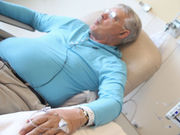That translates to an additional 1.7 million survivors
THURSDAY, Jan. 7, 2016 (HealthDay News) — Since peaking in 1991, cancer mortality rates in the United States have dropped by 23 percent, according to findings included in Cancer Statistics, 2016, the American Cancer Society’s latest annual report on cancer incidence, mortality, and survival. The report was published online Jan. 7 in CA: A Cancer Journal for Clinicians.
The data were collected from the U.S. National Cancer Institute’s Surveillance, Epidemiology, and End Results program and other sources. Over the past decade, the rate of cancer deaths has dropped by 1.8 percent a year in men and 1.4 percent in women, according to the report. The decline in the past 20 years has been driven by the continuous drop in deaths for four major cancer types: breast, colorectal, lung, and prostate.
Despite the progress, mortality rates for certain cancers are increasing. These include cancers of the liver, pancreas, and uterus. Thyroid cancers are the most rapidly rising, increasing more than 5 percent yearly in both men and women, the research revealed. However, some of that increase stems from overdiagnosis due to advanced imaging techniques.
“Cancer death rates are continuing to decline by about 1.5 percent per year,” study author Rebecca Siegel, M.P.H., strategic director for surveillance information services for the American Cancer Society, told HealthDay. The 23 percent drop in death rates occurred from 1991 through 2012, she said, and that translates to more than 1.7 million cancer deaths averted. “We are doing very well, I would say, is the bottom line,” she added.
Copyright © 2016 HealthDay. All rights reserved.








